September 05, 2008
 all dressed up, with nowhere to go..and this pisses them off!
all dressed up, with nowhere to go..and this pisses them off!They point out that while we have had the math worked out on reaching space for a century and we've been doing it for about half as long, it is still too great a hurdle for cheap access and large scale development.
This is a side effect of expendable launchers, which make sense from an engineering standpoint (they have maximum fuel efficiency and the highest payloads) but in an economic sense...they make no sense.
The problem here is that with the most current launch vehicles we are doing the equivalent of flying to Japan in a 747 and then blowing up the plane......every time. If that were the process for a transpacific flight..I could not have afforded to go to Japan last month.....just about no one could have.
So how do we fix the problem? Well obviously we make the damned thing reusable so you can fly it more than once!
While it may seem at first blush to be a dispatch from the department of "Duh!", that task is not as easy as it sounds...nor as impossible as some suggest.
NASA tried this in the 1970s with the space shuttle. It was compromised from the beginning by budget cuts and rather incompatible mission requirements. In fact, what was ultimately built was a pale image of most of the initial designs...
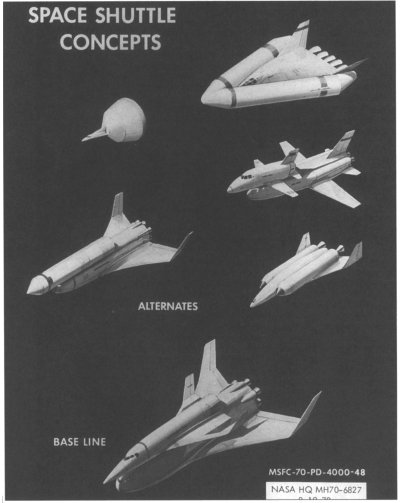
....but it was a successful attempt to do something that had never been done and it worked in that it got people into orbit and back.
However, it is not actually reusable. It drops bits, some of which ( the SRBs) can be refurbished at rather greater cost than it would take to assemble new
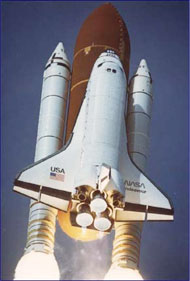 ones. More importantly upon landing it must be taken apart and
refurbished, then over several weeks have all the thrown away parts
(except the big tank...it gets a new one of those) reattached. I've
read that due in part to its low launch rate the space shuttle program
costs more per launch in adjusted dollars than a Saturn 5 launch to the
moon....note...For those of you outside of government, this is rather
not cost effective and defeats the actual stated purpose of the
project...which was to gain cheap access to space.
ones. More importantly upon landing it must be taken apart and
refurbished, then over several weeks have all the thrown away parts
(except the big tank...it gets a new one of those) reattached. I've
read that due in part to its low launch rate the space shuttle program
costs more per launch in adjusted dollars than a Saturn 5 launch to the
moon....note...For those of you outside of government, this is rather
not cost effective and defeats the actual stated purpose of the
project...which was to gain cheap access to space. With the amazing (and unfair) clarity of 20/20 hindsight, we would have been better off to just keep launching and throwing away Saturn 5s and maintaining a presence on the moon as well as possibly going to Mars a few times.
We probably would have had fewer than 14 killed in the process as well.
However that was unclear at the time.
The Shuttle is a remarkable achievement and a great deal was learned from it...20-30 years ago. There were proposals in the 80's and early 90's to develop a follow-on to capitalize on the many lessons that were learned, but Shuttle 2 and the other projects were canceled.
What was a brilliant engineering feat around 1980 now teaches us little except how to find new ways for astronauts to die. It is useful, nay vital because we have nothing else, and it is really the only vehicle that can service Hubble and fully service the International Space Station. Indeed Americans now launch more frequently on Russian rockets in the venerable Soyuz capsule than in the Shuttle.
The shuttle experience has soured a lot of people on cheap access to space, not the least a demoralized NASA, which is using ostensibly shuttle derived technology for the completely expendable Orion project. This seeks to reboot Apollo but with a much larger payload by virtue of using both an Earth and lunar rendezvous. In theory this is not an unreasonable method for getting people to the moon. (the original Apollo's lunar rendezvous worked remember) and the program is supposed to be using a large percentage of proven off the shelf hardware slightly modified to new requirements, which is not a terrible idea.
The program annoys many people because it would do nothing to gain us cheap access to space. However, the Moon/NEO/Mars missions are trailblazers in things other than propulsion (life support for instance) so it makes sense that the rockets are conservative.
Unfortunately, the "straightforward adaptation" has been anything but.
Bizarre engineering contortions have been made in order to make sure all current shuttle contractors have a piece of what should be a much simpler pie and even the solid rocket booster, which was to be adapted from the Shuttles is proving to be a very expensive "George Washington's axe". Worse, it is not working...the vibration problems are severe and NASA is now admitting that it will be, in all likelihood LESS SAFE than the space shuttle.
Oh...and it is taking 6 or 7 years longer than the Apollo program that started from scratch. It is likely the whole thing will have to be redesigned.
This has caused some of our libertarian friends, as well as actual rocket scientists to decry government involvement in moon shots, nay space flight in general and rely totally on the private sector. We here at Brickmuppet Blog are rather lonely in our disagreement on this point among space enthusiasts.
The federal government can do flags and footprints missions and set up bases ala Apollo 2.0 (but perhaps with different architecture). The Space agency, however, should build its program around commercial rockets and spacecraft. If there is something that is not available put out a bid. Things like propellant depots and commercial contracts for supplying the Space Station are certainly things that should be pursued preferably with prizes for reaching performance and ease-of-maintenance goals in addition to programs along the lines of the now rather gutted COTS program. This would kill the chicken-egg problem we have now. I realize that this is not a popular opinion right now, but I think that Lewis and Clark is a good model for the Space program as is the interstate highway system to a lesser extent.
However, in order to really open up space we need more than Lewis and Clark...we need Conestoga wagons too. We need something that can take people and stuff into space in a cost effective manner. This, as we have said is challenging.
In order to get into orbit you have to get above the sensible atmosphere, and you have to be going really fast. I mean REALLY fast. A minimum 'permanent' orbit at about 150 miles up requires you accelerate your spaceship to 17,000 miles per hour, other orbits require more speed and leaving Earth entirely requires a minimum of 25,039 miles per hour. The visible moon and the Lagrange points require about that (actually a hair less, since they are actually part of the cislunar system). Getting anywhere beyond the moon requires at least a tad more unless one just wants to orbit the sun. Now this requires a lot of thrust...continuous thrust that is in toto greater than the mass of your vehicle, in order to get it off the ground, and it requires that thrust be maintained for the entire trip, which requires fuel...which has weight....more thrust requires more fuel to be used per second....fuel that must be carried...which has weight.
The more fuel you carry the more weight you must lift the more thrust you require...which requires more fuel...which starts the vicious cycle over again. Ultimately you need a very large tank (actually tanks, unless you use a monopropellant)
Earth has about the highest SURFACE gravity of any body in the Solar System aside from the Sun and Jupiter* It sucks to be us.
This is why most space rockets stage, you throw away the unnecessary portions of the tank and get lighter faster as you rise than you would if you just burned fuel. It makes the engineering problems rather less challenging, but it leads to very expensive operations.
Now some people say that a single stage to orbit and back craft is impossible,the aforementioned disillusionment with the Shuttle having convinced them of this. Others disagree.
Which brings us to this piece by Dr. Jerry Pournelle which is really a must read for anybody interested in the field.
Dr. Pournelle has some experience in space access as he worked with the late Max Hunter on the DC-X prototype. This was an ambitious project to incrementally develop a reusable launch capability, as opposed to the rebuildable one we have now. DC-X was a test rig and as such was quite successful, even its mishaps taught its developers a lot. DC-X was to be followed up by DC-X2 and ultimately DC-Y and its developments.
Neither of these designs were cast in stone in any way as they would each be developed with lessons learned from their predecessors. McDonnell Douglas pulled the plug shortly after the mergers of the mid-90s meant that the DC-X program was in competition with its expendable booster business. NASA chose to go with the X-33/Venture Star and this X project was shelved.
There is more on this interesting project here.
Now, this kind of hands on approach is, today, generally regarded as redundant when we have computer modeling, but there is really no substitute for hands on tests.
There is no difference between theory and practice...in theory....but in practice there is.
Want an example?
One of the things that was learned was that although on paper Hydrogen is the best rocket fuel with the best power to weight ratio, operationally from a commercial perspective, it SUCKS. Liquid hydrogen is incredibly hard to handle which pushes up costs, complexity and safety problems. Additionally, despite how good its energy density by weight is, that leads to diminishing returns because it has such has poor energy density by volume, which requires a huge tank (insulated to boot), which pushes up weight and reduces strength.
NASA has certainly used H2 quite successfully, but they use infrastructure built for the moon shots for which cost was no object. They also are rather unconcerned about boil-off since they can make more at the big facilities that hydrogen rockets are used. There are various safety issues with handling something that is almost absolute zero.These don't matter to NASA as they can just ad more infrastructure and people...which translates into more pork for the associated congresscritters...which in a perverse way actually eases their budget request....so there is an intense NEGATIVE pressure on cost effectiveness.
Assuming it can be built, a single stage to orbit rocket will have a very small percentage of its mass be payload, perhaps less than 1%, meaning that a useful payload to low earth orbit will require a very large rocket, however this is not the hurdle some seem to think it is.
For one thing, the simplicity of operation that the single stage to orbit gives a lot of operational advantages and vastly increases the commercial viability of it. This approach is challenging but if it works the payoff is great. Dr. Pournelle is convinced it has a better than even chance of working and there is no reason to doubt him. Even if the program failed to reach orbit in one stage the lessons learned in such a test program.... ....running...stopping,...tweaking...running again...
...stuff we haven't done since the '60s...
...would teach us a lot about the new aerospace materials that one can't get from computer models. In the highly unlikely event this approach is utterly untenable it would still have applications in a multi stage system.
It is quite possible that Jeff Bezos is already taking this approach.
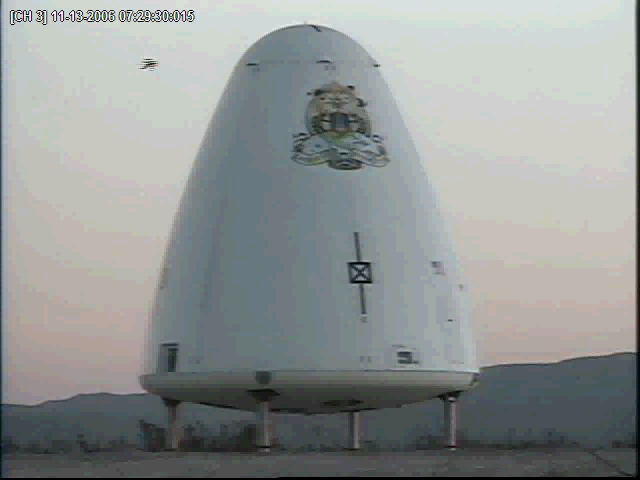
Two and two and a half stage designs are already doable, indeed they figured heavily in the original shuttle concepts. They have the disadvantage of added operational complexity but a higher percentage of their launch weight being payload. They also have the potential to be more robust structurally.
This is ( think) a picture of the proposed Space Sortie Vehicle from 1983-85. It used an expendable tank but was otherwise completely reusable. A fine development of the lessons learned from the Space Shuttle. It could have complimented that vehicle nicely or replaced it for manned flights. Indeed, I'm told it was cancelled in part due to congressional fears that its far simpler, cheaper operation would cause abandonment of the Space Shuttle and its standing army of constituents. Unlike some other designs this particular design was pretty conservative.
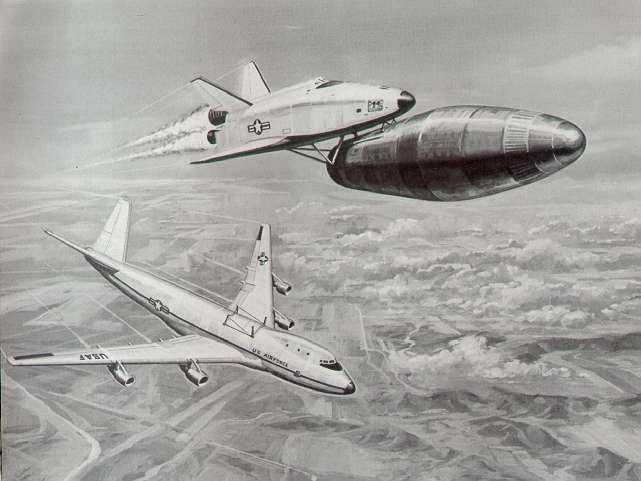
There are other ways to get to orbit besides the above mentioned liquid fuel rockets.
Ignoring the holy grail that is the space elevator, there are solid rockets, Scramjets, HELL rockets, and cannon.
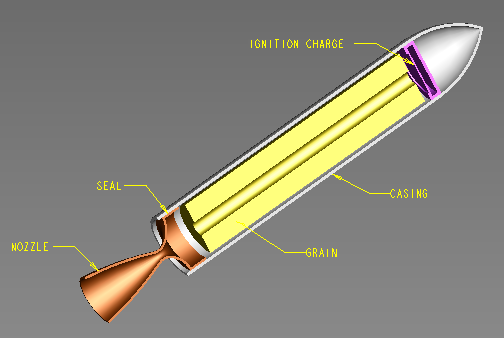
Solid Rockets are in concept the most primitive rockets, their invention by the Chinese predating actual firearms. They don't have the thrust to weight ratios that liquids have, but they have very good acceleration. They are generally used for niche applications, but despite their drawbacks can be used to get to orbit. France entered space using the all solid Diamant launchers and the Brits, in the 1930s, using the low performance solids of the time, worked out the math for a manned lunar mission! They got around the significant performance deficits of solids by having their rocket have 7 stages. Solid motors have few if any moving moving parts and are widely used for missiles. This has led some people to advocate them for manned space flight. One reason is that since solids are so simple they can in theory be mass produced modularly and offset through economies of scale and volume the face that they are disposable. They would still be more expensive than a a DCY to operate but they might be a considerable improvement on the current designs.
This is problematic for several reasons.
Solids have very poor performance in comparison with liquids.
Solids can't be turned off once ignited.
Most high performance solids are quite toxic and their exhaust is not particularly pleasant either.
Solids can't be refueled except at the factory and it is almost always cheaper to build a new rocket.
Solids are filled with large amounts of rubbery explosive and if that cracks in shipping, it alters the geometry of their burn...this is more a problem of scaling to the large combustion chambers needed for spaceflight than anything else....It seems to be vanishingly rare in much smaller guided missiles for instance...it does not seem to be not terribly common in space rockets but it can lead to burn efficiency issues, and even the cracking the rocket body itself . This can be spectacularly bad....
Thus despite some rhetoric to the contrary...solids are not inherently safe.
They also cannot be refueled in situ so they are of limited applications for deep space exploration where hydrocarbons and oxygen can be produced in several places.
An interesting development of solid rockets is the hybrid rocket. This was developed by the now defunct AMROC corporation and is the basis of Spaceship One and Two. It uses a solid motor, but the oxidizer, either a liquid or a gas, is separate and its flow can be controlled. This adds throtallability, and (in theory) a restart capability! These things have several other advantages but their development has had some setbacks. 3 Scaled Composites employees were killed when a hybrid engine exploded last year. Nevertheless a hybrid powered the ascent of the historic Spaceship One and
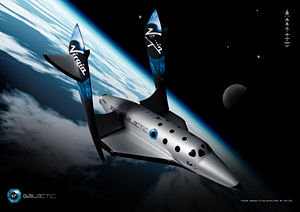 they are the basis of the first commercial manned spacecraft Spaceship Two. Note that although it is a very cool thing and a spectacular achievement, SS2
is nowhere near approaching orbit, though as pointed out here it is not as far as some claim (Scaled Composites claims the Spaceship Two motor could put something akin to a Mercury capsule into orbit, although only the first stage would be reusable, this would be an exceedingly neat stunt). Solids and hybrids certainly have at least niche applications for the foreseeable future.
they are the basis of the first commercial manned spacecraft Spaceship Two. Note that although it is a very cool thing and a spectacular achievement, SS2
is nowhere near approaching orbit, though as pointed out here it is not as far as some claim (Scaled Composites claims the Spaceship Two motor could put something akin to a Mercury capsule into orbit, although only the first stage would be reusable, this would be an exceedingly neat stunt). Solids and hybrids certainly have at least niche applications for the foreseeable future.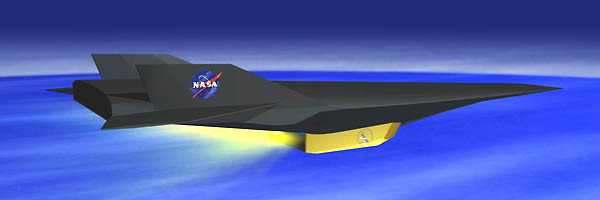
Scramjets have potential but have been really challenging. They gain a big advantage over rockets by breathing air for most of their ascent meaning that they don't have to carry their own oxidizer except for the last little boost. The mechanics of scramjets are far more complex than a rocket though. It is still possible that scramjets are going to be the breakthrough in single stage to orbit tech we all hope for but my money is still on rockets.
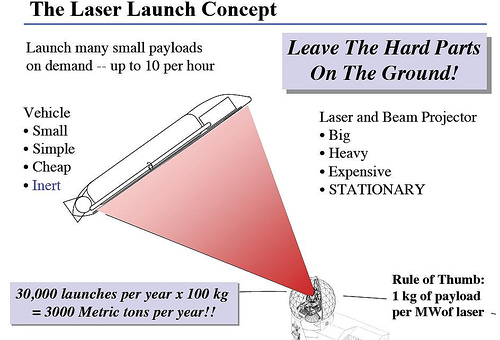
HELL rockets or high energy laser launcher rockets are simple rockets that pump a working fluid...perhaps water....into a combustion chamber. Then a REALLY high powered laser beneath vaporizes it and continues to vaporize it as it is pumped...all the way to orbit. This has the potential to have much better thrust to weight ratios than regular rockets. Laser and targeting technology advances make this not all that far fetched.
The demerits are the fact that it restricts launch facilities to large facilities with Lasers...and the government is likely to hyperegulate any industry that has big ass lasers that can by definition knock out satellites or devastate a structure on the moon...or cut an aircraft carrier in half.... The ASAT potential alone makes them problematic legally.
Note however that these are nontechnical hurdles. In fact Laser launchers can in theory be scaled up to allow interstellar missions. (image nicked from Brian Wangs superb site)
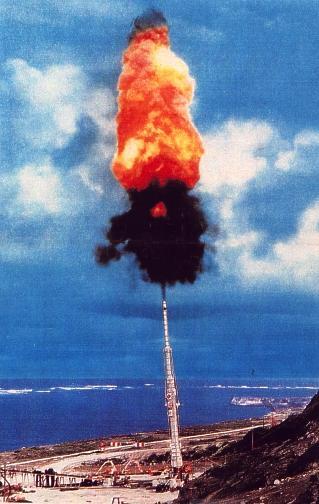
Guns ...(yes guns)...were the first method considered for space launchers. Newton used a cannon firing from a really high mountain to illustrate the possibility of achieving orbit. Jules Verne's Columbiad notwithstanding, the first serious study of this was the US/Canadian HARP project of the 1960s which used modified 16" battleship rifles to launch small payloads to extremely high velocities and altitudes. The original guns put limits on the performance (this was NOT in their design capability) but a 7" 50 pound projectile was designed for launch before the project was canceled. Guns can be regular cannon as above, electromagnetic railguns or light gas guns.
The downside is that the payload accelerates...well...like a speeding bullet, so its inappropriate for passengers except as an expensive means of capital punishment. Even nonliving payloads have to be quite robust...but this might be a good method for launching water, food or structural components. The conventional cannon could be built today (it was working in the 1960's) and might make up for its small payload in "rate of fire".
Keeping in mind my stock disclaimer, barring a major breakthrough or secret project this is where launch tech is right now. We often post on farther term projects like space settlement and asteroid mitigation but this very solvable problem is the first hurdle to our future in space.
UPDATE 12/16/08: Rand Simberg...an actual rocket scientist...has related thoughts in this excellent, never before published in full article from 2004.
* the 3 smaller gas giants SURFACE gravity is actually in the same ballpark as Earth, though they are much more massive with their atmospheres.
"Science Babes" are of course the Rocket Girls...from Rocket Girls.
UPDATE 9/7/08: Thanks to Pete Zaitcev in the comments for pointing out my error regards the orbital potential of the Scaled Composites system. The text on the solid rockets has been amended to reflect the correct data...also added hyperlinks and additional pictures and corrected clumsy syntax.
Posted by: The Brickmuppet at
08:19 PM
| Comments (6)
| Add Comment
Post contains 3202 words, total size 24 kb.
http://selenianboondocks.blogspot.com/2007/04/myth-of-25x.html
Ubu's numbers may be correct, but they're not telling the whole story when comparing SS2 and orbital launchers.
Posted by: Pete Zaitcev at Fri Sep 5 23:06:20 2008 (/ppBw)
Thanks for the post, Ken. That made for some interesting reading. I've bookmarked it for future reference, as well.
If you can find a copy available, there's a book from '78 that the AIAA put together showing where the STS program was "supposed" to go. The title on it is "Space Transportation Systems: 1980-2000," and it was edited by Salkeld and Patterson. A number of Shuttle follow-ons and interim-upgrades (which we naturally never went with) are covered in great detail. It's a crying shame that none of the lessons of the Shuttle are being built into its intended successor - and almost a big a shame that we're not looking to fix much of the easier problems on the current equipment, either.
If I may, where did you find the info for the SSV? Something similar is used as a design study in the AIAA book, but that's the first I've heard of it as something studied in any kind of "official" capacity.
Posted by: Rich Anderson at Sat Sep 6 21:18:13 2008 (iGCiD)
If I may, where did you find the info for the SSV? Something similar is used as a design study in the AIAA book, but that's the first I've heard of it as something studied in any kind of "official" capacity.
I first heard about in in a Popular Mechanics article in the 80s, and it has appeared from time to time in internet searches. It is mentioned in a very brief entry at astronautix.com and in Millers The Dream Machines which is long out of print. While researching this post I found what is the most complete overview of it I've found on the Secret Projects Board here. note that to see the images (one of which I nicked) you need to register.
There is a very similar proposal (independently developed it seems) in Russia that is an on again off again proposition called MAKS.
Posted by: The Brickmuppet at Sat Sep 6 23:54:19 2008 (V5zw/)
I've been following the attempts to develop CATS since 2001 or so (indeed he first blogs I found were space ones link Hobbyspace).
It does seem that everything it due to happen '3-4 years from now, but I'm still cautiously optamistic that it will happen.
Now that there are a number of individuals putting serious cash into it (Bezos, Musk and so on), It looks more likley than at any time since the 80's. I still recon I'll to be able to retire to the belt (though LEO would be enough)
Posted by: Andrew Janes at Sun Sep 7 15:23:12 2008 (h7yN2)
Thanks for the references. Another source to scour is always a good thing.
A thought occured regarding the acceleration of the gun-type launch vehicles, I'm curious why it would be a bad idea to use an electromagnetic mass driver set up in a loop, with a spur-track coming off at a tangent for the final loft. The loop would be where you could come up to speed over as much time as needed before the final few m/s of vee are added in the spur-track. Accelerations could then be anything from a few tenths of G up to multiple 10s of G. The only really difficult part would be designing the "switch" point, which is somewhat amusing - Dr. O'Neill made his fame for writing "The High Frontier," but made his career and earned his Nobel for designing that very "switch" for use with particle accelerators back in the 1950s. If Ken or Pete or anyone can point out the flaw in this reasoning, I'd be grateful.
Posted by: Rich Anderson at Sun Sep 7 16:22:55 2008 (HzN2k)
I think that regards the "switch" you are referring to, for it to have applications for a useful payload, it would have to be vastly more problematic than manipulating magnetic fields. Rather than magnetic fields to bend the course of subatomic particles (which are pretty robust...that's why we need big apparatus to break them) this would require something akin to a train switching tracks at a high Mach number. Also, running at a high Mach number on the ground has noise issues and the potential for damage not only to the surounding area, but the device itself as the sonic boom might be reflected back on it due to the close proximity to the ground.
This doesn't get into the effect of really high powered magnetic fields on biological processes such as brain activity or movement of hemoglobin.
There may be work-arounds for this but I don't see them in the near term.
Posted by: The Brickmuppet at Sun Sep 7 19:59:10 2008 (V5zw/)
69 queries taking 0.1038 seconds, 381 records returned.
Powered by Minx 1.1.6c-pink.









